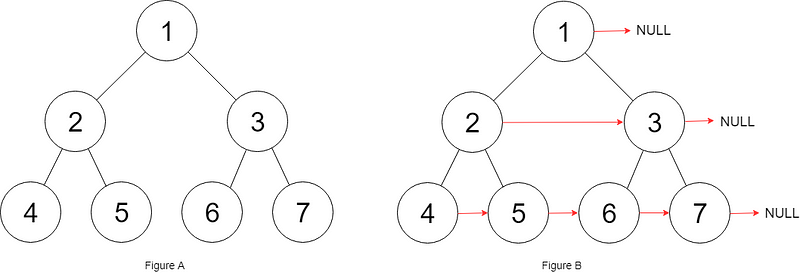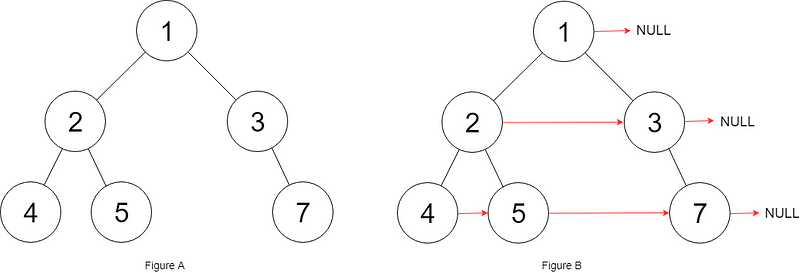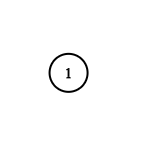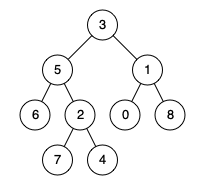Data Structure: Interview Experience Part 4(Microsoft)
Data Structure: Interview Experience Part 4(Microsoft)
Graph and Tree

1. Given a binary tree, determine if it is a valid binary search tree (BST). Assume a BST is defined as follows:
- The left subtree of a node contains only nodes with keys less than the node’s key.
- The right subtree of a node contains only nodes with keys greater than the node’s key.
- Both the left and right subtrees must also be binary search trees.
Example 1:
2
/ \
1 3
Input: [2,1,3]
Output: true
Example 2:
5
/ \
1 4
/ \
3 6
Input: [5,1,4,null,null,3,6]
Output: false
Explanation: The root node's value is 5 but its right child's value is 4.
Practise: https://leetcode.com/problems/validate-binary-search-tree/
2. Given a binary tree, return the inorder traversal of its nodes’ values.
Example:
Input: [1,null,2,3]
1
\
2
/
3
Output: [1,3,2]
Follow up: Recursive solution is trivial, could you do it iteratively?
Practise: https://leetcode.com/problems/binary-tree-inorder-traversal/
3. Given a binary tree, return the level order traversal of its nodes’ values. (ie, from left to right, level by level).
For example:
Given binary tree
[3,9,20,null,null,15,7],
3
/ \
9 20
/ \
15 7
return its level order traversal as:
[
[3],
[9,20],
[15,7]
]
Practise: https://leetcode.com/problems/binary-tree-level-order-traversal/
4. Given a binary tree, return the zigzag level order traversal of its nodes’ values. (ie, from left to right, then right to left for the next level and alternate between).
For example:
Given binary tree
[3,9,20,null,null,15,7],
3
/ \
9 20
/ \
15 7
return its zigzag level order traversal as:
[
[3],
[20,9],
[15,7]
]
Practise: https://leetcode.com/problems/binary-tree-zigzag-level-order-traversal/
5. You are given a perfect binary tree where all leaves are on the same level, and every parent has two children. The binary tree has the following definition:
struct Node {
int val;
Node *left;
Node *right;
Node *next;
}
Populate each next pointer to point to its next right node. If
there is no next right node, the next pointer should be set to
NULL.
Initially, all next pointers are set to
NULL.
Follow up:
- You may only use constant extra space.
- Recursive approach is fine, you may assume implicit stack space does not count as extra space for this problem.
Example 1:

Input: root = [1,2,3,4,5,6,7]
Output: [1,#,2,3,#,4,5,6,7,#]
Explanation: Given the above perfect binary tree (Figure A), your function should populate each next pointer to point to its next right node, just like in Figure B. The serialized output is in level order as connected by the next pointers, with '#' signifying the end of each level.
Constraints:
-
The number of nodes in the given tree is less than
4096. -
-1000 <= node.val <= 1000
Practise: https://leetcode.com/problems/binary-tree-zigzag-level-order-traversal/
6. Given a binary tree (Populating Next Right Pointers in Each Node II)
struct Node {
int val;
Node *left;
Node *right;
Node *next;
}
Populate each next pointer to point to its next right node. If
there is no next right node, the next pointer should be set to
NULL.
Initially, all next pointers are set to
NULL.
Follow up:
- You may only use constant extra space.
- Recursive approach is fine, you may assume implicit stack space does not count as extra space for this problem.
Example 1:

Input: root = [1,2,3,4,5,null,7]
Output: [1,#,2,3,#,4,5,7,#]
Explanation: Given the above binary tree (Figure A), your function should populate each next pointer to point to its next right node, just like in Figure B. The serialized output is in level order as connected by the next pointers, with '#' signifying the end of each level.
Constraints:
-
The number of nodes in the given tree is less than
6000. -
-100 <= node.val <= 100
Practise: https://leetcode.com/problems/populating-next-right-pointers-in-each-node-ii/
7. Given preorder and inorder traversal of a tree, construct the binary tree.
Note:
You may assume that duplicates do not exist in the tree.
For example, given
preorder = [3,9,20,15,7]
inorder = [9,3,15,20,7]
Return the following binary tree:
3
/ \
9 20
/ \
15 7
Practise: https://leetcode.com/problems/construct-binary-tree-from-preorder-and-inorder-traversal/
8.
Given a 2d grid map of '1's (land) and '0's (water), count the number of islands. An island is
surrounded by water and is formed by connecting adjacent lands
horizontally or vertically. You may assume all four edges of
the grid are all surrounded by water.
Example 1:
Input: grid = [
["1","1","1","1","0"],
["1","1","0","1","0"],
["1","1","0","0","0"],
["0","0","0","0","0"]
]
Output: 1
Example 2:
Input: grid = [
["1","1","0","0","0"],
["1","1","0","0","0"],
["0","0","1","0","0"],
["0","0","0","1","1"]
]
Output: 3
Practise: https://leetcode.com/problems/number-of-islands/
9. Clone Graph
Example 1:

Input: adjList = [[2,4],[1,3],[2,4],[1,3]]
Output: [[2,4],[1,3],[2,4],[1,3]]
Explanation: There are 4 nodes in the graph.
1st node (val = 1)'s neighbors are 2nd node (val = 2) and 4th node (val = 4).
2nd node (val = 2)'s neighbors are 1st node (val = 1) and 3rd node (val = 3).
3rd node (val = 3)'s neighbors are 2nd node (val = 2) and 4th node (val = 4).
4th node (val = 4)'s neighbors are 1st node (val = 1) and 3rd node (val = 3).
Example 2:

Input: adjList = [[]]
Output: [[]]
Explanation: Note that the input contains one empty list. The graph consists of only one node with val = 1 and it does not have any neighbors.
Example 3:
Input: adjList = []
Output: []
Explanation: This an empty graph, it does not have any nodes.
Example 4:

Input: adjList = [[2],[1]]
Output: [[2],[1]]
Constraints:
-
1 <= Node.val <= 100 -
Node.valis unique for each node. - Number of Nodes will not exceed 100.
- There is no repeated edges and no self-loops in the graph.
- The Graph is connected and all nodes can be visited starting from the given node.
Practise: https://leetcode.com/problems/clone-graph/
10. Given a binary search tree (BST), find the lowest common ancestor (LCA) of two given nodes in the BST.
According to the definition of LCA on Wikipedia: “The lowest common ancestor is defined between two nodes p and q as the lowest node in T that has both p and q as descendants (where we allow a node to be a descendant of itself).”
Given binary search tree: root = [6,2,8,0,4,7,9,null,null,3,5]

Example 1:
Input: root = [6,2,8,0,4,7,9,null,null,3,5], p = 2, q = 8
Output: 6
Explanation: The LCA of nodes2and8is6.
Example 2:
Input: root = [6,2,8,0,4,7,9,null,null,3,5], p = 2, q = 4
Output: 2
Explanation: The LCA of nodes2and4is2, since a node can be a descendant of itself according to the LCA definition.
Constraints:
- All of the nodes’ values will be unique.
- p and q are different and both values will exist in the BST.
Practise: https://leetcode.com/problems/lowest-common-ancestor-of-a-binary-search-tree/
11. Given a binary tree, find the lowest common ancestor (LCA) of two given nodes in the tree.
According to the definition of LCA on Wikipedia: “The lowest common ancestor is defined between two nodes p and q as the lowest node in T that has both p and q as descendants (where we allow a node to be a descendant of itself).”
Given the following binary tree: root = [3,5,1,6,2,0,8,null,null,7,4]

Example 1:
Input: root = [3,5,1,6,2,0,8,null,null,7,4], p = 5, q = 1
Output: 3
Explanation: The LCA of nodes5and1is3.
Example 2:
Input: root = [3,5,1,6,2,0,8,null,null,7,4], p = 5, q = 4
Output: 5
Explanation: The LCA of nodes5and4is5, since a node can be a descendant of itself according to the LCA definition.
Note:
- All of the nodes’ values will be unique.
- p and q are different and both values will exist in the binary tree.
Practise: https://leetcode.com/problems/lowest-common-ancestor-of-a-binary-tree/
Hope this article is useful for people looking to learn and practice Data structure & Algorithm in swift, Please ❤️ to recommend this post to others 😊. Let me know your feedback. :)